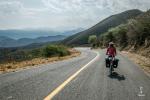
The European market potential for cycling tourism
Cycling tourism offers a diverse market. Germany and the United Kingdom are the largest source markets for cycling tourism, followed by the Netherlands. The demand for this niche market is increasing, partly accelerated by the COVID-19 pandemic and the urge to explore nature. Cycling tourism offers many opportunities, including an experience with the local community, cycling tours using unpaved roads, advertisement via specific cycling-focused media and the new possibilities that come along with e-bikes.
Contents of this page
1. Product description
Cycling tourism refers to recreational visits away from home which involve leisure cycling as a fundamental and significant part of the trip. Bicycle holidays give travellers a feeling of independence and flexibility. Cyclists can decide when and how fast they want to bike. Cycling can be a sporty, peaceful and social activity, often enjoyed in nature. Cycling tourism is becoming more and more popular among different groups, such as younger adults, elderly people and sometimes families.
Cycling tourism is built up out of 4 specialist niches: Road Cycling, Mountain Biking, Family Cycling and Touring/Expedition. When offering cycling tourism, it is essential that you are aware of the different specialist niches and their demands. Below, you will find a description of each with examples of fitting tours.
Table 1: Specialist niches with example tour operators
| Specialist Niche | Meaning | Example |
| Road Cycling | Road cycling is a sport in which cyclists cycle fast on asphalted and sometimes paved roads. | The South African-based Cape Cycle Tours offers road cycling and mountain bike tours in South Africa. The company emphasises the tour guide’s cycling expertise and shows pictures of the tour on its website. |
| Mountain Biking | Mountain biking is a sport over rough terrains. Mountain bikers want challenging trails in the forests or mountains. | Haku Expeditions is a South American-based tour operator that provides a variety of mountain bike tours. It gives clear descriptions of the kind of trails and sights bikers can expect. It also informs you about the skill required for each tour. |
| Family Cycling | Family cyclists go on family cycling trips. These trips are often day or multi-day trips. It is important that the distance and activities along the way are suitable for children. | Saddle Skedaddle is a British tour operator that provides a variety of biking holidays. It provides a guided family holiday with various side activities suitable for children like ziplining, camping and surfing lessons. Saddle Skedaddle also shows an overview of what activities and cycle distances the family can expect. |
| Touring/Expedition | Tour cyclists enjoy cycling as a relaxing hobby. They go on one-day, multi-day or multi-week tours. These tourists enjoy the physical activity but are normally not interested in practising cycling as a sport. | Trails & Travel provides self-guided cycling and bikepacking tours in South Africa. It provides maps that are accessible via GPS and on PDF to navigate at all times. You can decide if you want to make use of the transport service, hotels or B&B or go camping. Lastly, it provides sightseeing, restaurant and wine-tasting tips. Red Dirt Uganda offers guided cycling tours in Uganda and Rwanda. Its tour description includes information on accommodation, difficulty and sights. Thorn Tree Safaris offers trips through Zambia for small groups, offering accommodation, food and water and support during a trip. |
The big niche of Mountain biking includes several passion groups: cross country, single-track riding, gravel biking, all mountain, downhill, free riding and dirt jumping.
Table 2: Passion groups within the mountain biking specialist niche
| Passion groups | Meaning | Example |
| Cross Country | Cross country is the most popular kind of mountain biking. Cross-country mountain bikers like to travel from one place to the next, tackling rough terrains. | MBT South Africa is a tour operator that provides various mountain biking tours. It provides one-day and multi-day tours. Next to the tours, MBT South Africa provides extensive information on self-guided tours. It shows pictures and videos of the trails to let its customers know what they can expect. Another example is offered by Exodus Travels, which offers a guided bike trip through Jordan’s highlights, Petra and the beautiful deserts of Wadi Rum. |
| Single Track | Single-track mountain biking is the same as cross-country mountain biking, only these mountain bikers like to follow narrow paths that are especially designed for single-track mountain biking. | Awol Tours offers day-trip mountain biking tours that mainly follow single tracks. For most routes, they provide a blog post or a video of the route. |
| Gravel Bike | These bikers explore various terrains with their mountain bikes. Gravel bikes are suitable for riding on all sorts of paths, like gravel, forest and single track. | Thomson is a tour operator specialised in bike tours. One of its offers is a Morocco gravel tour for adventurers and challenge seekers. |
| All Mountain (Enduro) | All-mountain bikers bike in mountainous areas with climbs and descents. Being able to make sharp turns is especially important. | Patagonia is a tour operator that provides mountain-rich routes in many developing and other countries. It describes the daily planning and shows videos of previous tours. Next to that, it provides practical information about luggage, equipment and clothing. |
| Downhill | Downhill mountain bikers are thrill seekers. They want to go downhill as fast as possible. They usually do not bike uphill and will often make use of lifts or pick-up services to bring them to the top. | Loose Riders Travel takes you to Asia to explore the rough biking trails. It offers a specific holiday for downhill mountain bikers in the jungle of Thailand, to unspoiled nature, tight-knit jungle and challenging downhill trails. |
| Freeriding | Freeriders like to bike on very challenging paths that often do not seem like paths at all. Freeriders often like to do tricks and jumps. | Bikepark Winterberg is a park in Germany that describes various freeride and regular mountain bike trails. It also sells and rents out bikes and provides freeride courses and side activities like a forest adventure park. |
| Dirt Jumping | Dirt jumpers like to challenge themselves with ramps and doing tricks while jumping. Dirt jumping follows short and often circular trails. Doing tricks and jumping high is most important to them. | Hong Kong Bike Training Centre provides various one-day courses including dirt jumping courses. It provides different courses for the various levels of experience. |
Tips:
- Cycling is related to sport, nature and adventure tourism. Read more about each in CBI’s studies about sport tourism, nature and ecotourism and adventure tourism.
- Inform yourself about the different tourism niche markets to be able to make a clear choice on what you want to offer to who. CBI offers an infographic which gives a clear overview of all segments and niche markets in tourism.
- Focus on only a few specialist niches or passion groups and gather intelligence on the bikers you want to attract and the bikes needed.
- Provide locks and sheds at overnight stays to prevent theft. Cyclists find it important to park their bike safely when they stay overnight.
It is important to know about the different types of cycling tourists and their demands. Europeans will trust you more if you provide a lot of information and show you know a lot about your offering. Europeans’ demands vary by age, specialist niche and accommodation type:
Market segmentation by age group
Older cyclists and young adults are the most important target groups for cycling tourism. Which of these target groups you should focus on depends on your offering. Younger adults are often more active cyclists. Elderly people usually have enough free time to go on a cycling trip. Millennials with children are less likely to go on cycling holidays because it is more difficult to organise suitable cycling trips with children.
It is important for you to know about the different demands of the main target groups. Table 3 summarises the most important differences between younger and older cyclists. However, be aware that this is a generalisation, and there are many exceptions.
Table 3: Summary of the differences between younger and older cycling tourists
| Younger cyclists | Older cyclists | |
| Way of travelling | Minimalistic | Luxurious |
| Roads | Off the beaten track | Well paved |
| Service | Basic | Pick-up for luggage |
| Accommodation | Campings and homestays | Hotels |
| Destinations | Regional | Long-haul |
| Food | Healthy but budget | Fancy |
Market segmentation by specialist niche
Cycling tourists also have different demands depending on the specialist niche and the length of the cycling trip.
Road cyclists
Road cyclists enjoy high-speed and streamlined cycling. It is a sport mainly practiced by men. Road cyclists are also often higher educated and aged between 18 and 49 years old. Most road cyclists like to practice alone, while some enjoy cycling in small groups. The main motivations for road cycling are to exercise and to enjoy nature. These cyclists find asphalt roads or roads with minimal obstacles important, so they can cycle at high speeds.
Road cycling is a high-intensity exercise. Therefore, road cyclists often want high-calorie meals to sustain them throughout the day. The number of kilometres covered by road cyclists varies depending on their fitness level, the weather and road conditions. Short distances are usually between 15 and 25 km. More experienced road cyclists can cycle anywhere from 30 to 200 km.
Lastly, road cyclists are more likely to choose a pick-up service for their luggage. They need to have minimal weight with them during cycling so they can reach the speed they want. It is important for them to have their luggage delivered at their next accommodation if they do a multi-day travel route.
Figure 1: Road cycling means intense physical exercise
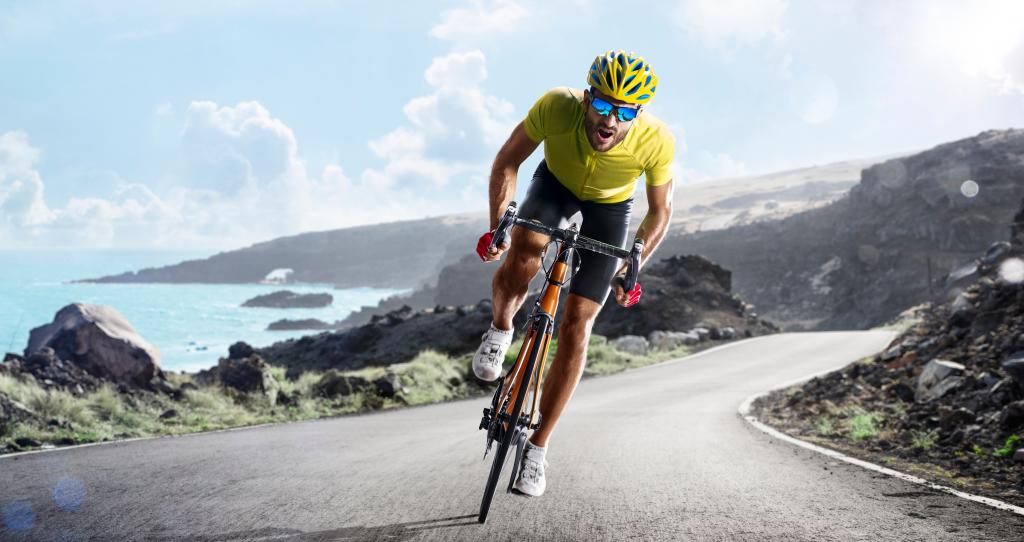
Source: Shutterstock
Mountain bikers
Mountain bikers often seek rough pathways with many dirt roads, such as forests and mountains. Most mountain bikers are aged 26-45 and are well educated. Europeans generally want more challenging trails compared to other nationalities. They enjoy challenging themselves physically as well as developing their mountain biking skills. Mountain bike tourists sometimes enjoy going on organised tours, but most mountain bikers organise their trip themselves. Organised tours are especially interesting for long-haul destinations. An example of an organised mountain bike trip is offered by Simien Eco Tours, where travellers are accompanied by German-speaking bike guides through Ethiopia.
Mountain bikers expect the description of the trails to be accurate. Information about and pictures of the trails are important. Mountain bike tourists are often experienced mountain bikers and know what they want when it comes to trails. A variety of paths is also important, so they continue to be challenged.
Mountain biking requires moderate-to-high fitness levels. Many bikers enjoy paths that have been specifically designed for mountain biking. This is because walking trails, asphalt and other roads are not ragged enough.
Mountain bikers usually bike for a few hours instead of the whole day. They often have some spare time left after mountain biking to do other activities. Most mountain bikers are not very demanding regarding their accommodation or food. They often enjoy simplicity.
Some tourists go mountain biking for one day. These tourists are usually not very experienced mountain bikers and will need easier trails to bike on.
Cross Country
Cross-country mountain bikers like to travel on rough paths. These paths are often found in forests and hilly areas. These bikers like the challenge of biking in robust landscapes and enjoy the physical endurance and skill that it requires. Cross-country mountain biking can be a day trip or a multi-day trip. Some bikers like to go with a guide, while others enjoy exploring on their own. The purpose of biking is to cover significant distances on challenging paths. Cross-country mountain biking is the most common form of mountain biking.
Trail Riding
Trail riding is similar to cross-country mountain biking, except they bike on very narrow trails called ‘single tracks’ instead of on wider paths. The narrow trails are often a bit more challenging than the broader trails cross-country bikers use. These bikers enjoy rough terrains with climbing and descending trails. They like to cover significant distances on challenging tracks. These tracks are often designed for trail riding specifically.
Gravel Biking
Gravel bikers ride specific bikes: gravel bikes. These bikes are suitable for various terrains such as gravel roads, forest paths and narrow trails. Gravel bikes have drop-down handlebars and are often suitable to carry luggage. This is why gravel bikers do not have to stick to one type of terrain. Gravel biking is becoming very popular because of the different routes bikers can take.
All Mountain
All-mountain bikers enjoy mountainous areas to bike on. The challenging features of all-mountain biking are the rocky surface and the often sharp climbs and descents. All-mountain biking requires skills to make sharp turns and jumps.
Downhill
Downhill mountain bikers, sometimes called ‘gravity riders’, are bikers that like to go down mountain trails as fast as possible. They enjoy the thrill of going fast on relatively dangerous paths. Downhill biking requires focus, skill and physical fitness. Lifts, such as ski lifts, or shuttle busses are common ways of transportation to get up the hill with their bikes.
Figure 2: Many downhill bikers favour paths in the woods
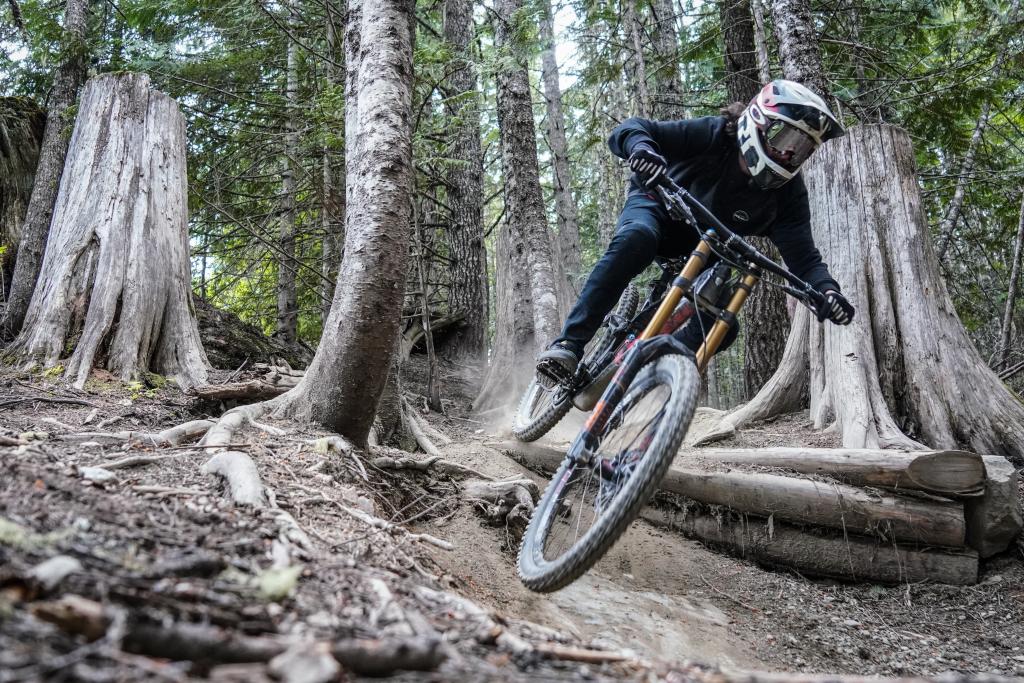
Source: photo by Danny Bor, via Pexels
Freeriding
Freeriders seek the same level of challenge downhill riders do. However, they do not necessarily go on downhill tracks but like to explore ultra-challenging pathways that often do not seem rideable at all. Freeriders look for even more robust areas or paths than cross-country bikers or trail riders do. Many freeriders enjoy doing tricks and jumps while biking. The trail should have enough ramps, jumps and obstacles for freeriders to enjoy. Freeriding is mostly done by men, but the number of freeriding women is increasing.
Dirt Jumping
Dirt jumpers are solely focused on jumping over ramps, often doing tricks while they jump. They use smaller bikes than mountain bikes and do not go on long distance trails. They require small, usually special-made trails that enable them to jump as high and as long as possible.
Downhill mountain bikers, freeriders and dirt jumpers do not bike to cover significant distances. They do it for the thrill of a track. These bikers will most likely bike for a day or half a day but not go on an organised tour.
Figure 3: Dirt jumpers use hills and obstacles to perform tricks
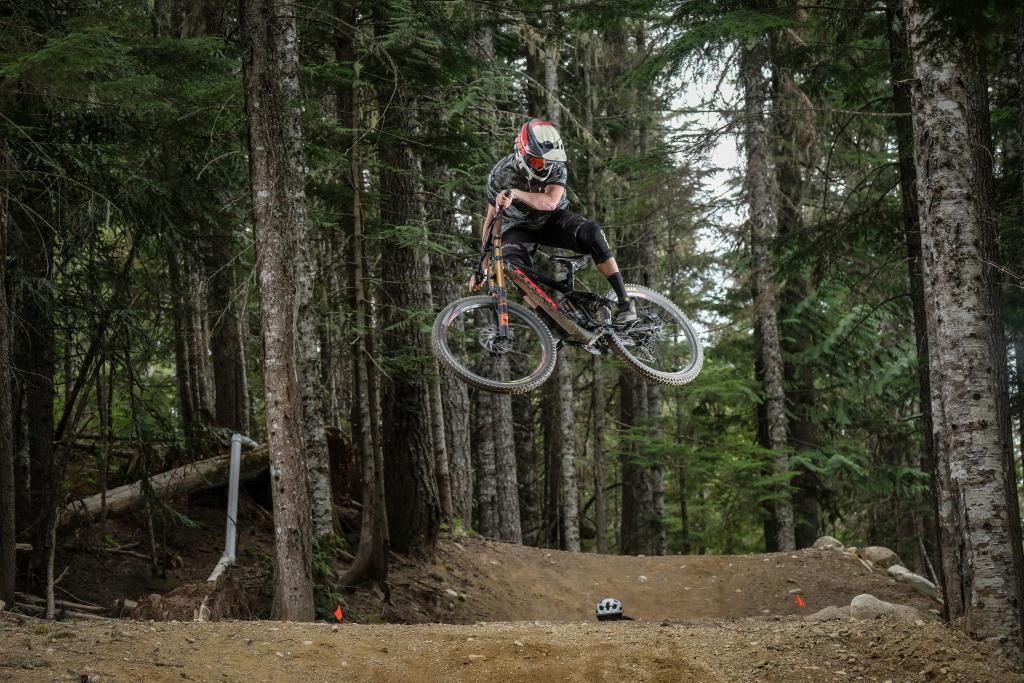
Source: photo by Danny Bor, via Pexels
Tips:
- Explore your area and inform yourself about the type of trails, roads and paths. Surrounding routes will determine the type of passion groups you can target. For road cyclists and mountain bikers, the quality of the trail is key in your offering.
- Offer tips or connect with local restaurants to make sure that cycling tourists get to know the local food or have a fancy meal at the end of their day. Providing healthy food is an important aspect of a cycling tour. Most road cyclists and mountain bikers favour high-calorie meals.
- Know your customers well. Europeans appreciate professional knowledge about the bicycles you provide. For example, inform yourself about gravel bikes if you want to attract gravel bikers.
Family cyclists
Family cyclists are people that go on a cycling holiday with children (0-14 years). Family cycling trips have increased, especially during COVID-19. These cyclists usually go cycling for one or a few days rather than one or more weeks. Family cycling holidays require more organisation and shorter distances, because children often get tired or bored more easily. Family cyclists often go camping or stay at a family accommodation rather than a hotel. This is partly because young children often do not cycle themselves, and parents seek an accommodation with sufficient space for children to use their abundant energy.
Breaks and family-friendly activities during the cycling tour are important for these tourists. Examples of family-friendly activities are safaris, treasure hunts and ziplining. Some families may want to use extra equipment, such as a children’s seat, follow-me or tandem bike. This makes it easier for children to come along.
Figure 4: Families with older children often use cycling bags for transportation
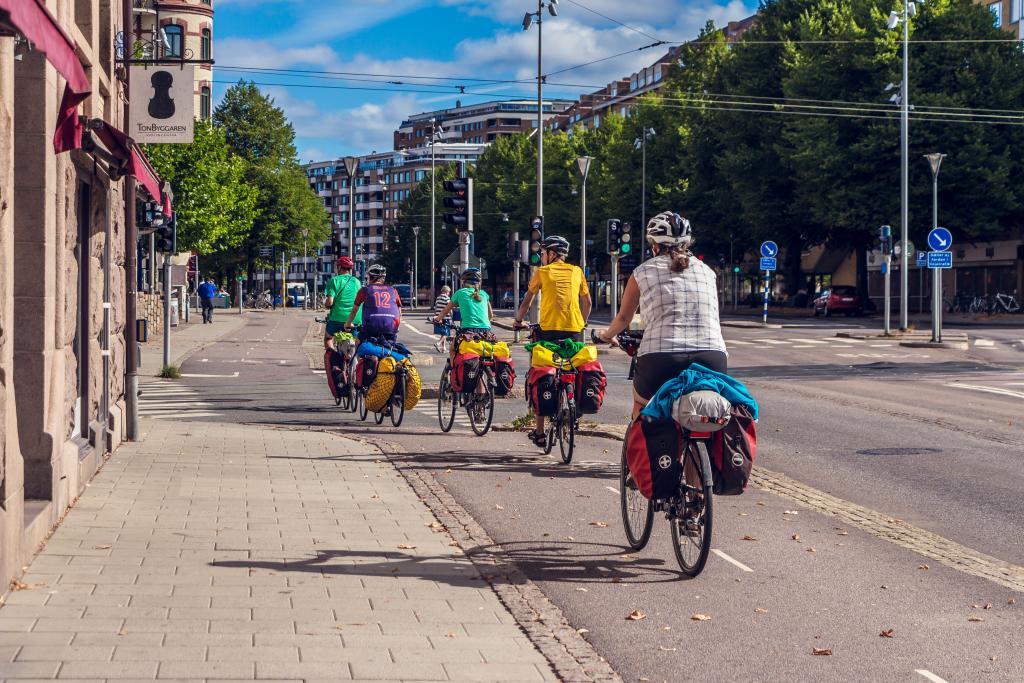
Source: Shutterstock
There are not many families that go on cycling holidays with children, because it is too inconvenient. And if they opt for a cycling holiday, they will most likely choose a destination nearby. Most families will travel with elder children only. Therefore, the demand for cycling holidays with young children on long-haul destinations will be very limited.
Tour cyclists
Tour cyclists offer the largest market in cycling tourism. Tour cyclists like to go cycling as a hobby and generally favour mapped-out cycling tours. The more information there is on a cycling tour, the more interesting a destination becomes for them. This lets tour cyclists know what facilities are provided and what sights they will come across.
For most road cyclists and mountain bikers, a trip is solely cycling related, but tour cyclists are more like ‘regular tourists’. Cycling is their mode of transport, and they use it to visit interesting places. Therefore, tour cycling can be combined with any other touristic activity, such as:
- visiting festivals, temples and other tangible and intangible culture;
- enjoying food and wine tours on their bike;
- visiting national parks to see wildlife;
- ending a cycling holiday with a few days of beach tourism (but probably a few days only).
A general difference between tour cyclists and other tourists is that tour cyclists mostly travel alone or with their partner, but they all love nature and favour active holidays.
Tips:
- Provide family and tour cyclists with a unique experience, in which they can experience the local culture. This way, you differentiate yourself from other offers. For example, Siem Reaper Travel provides a 4.5-hour tour in Cambodia. Tourists visit a local temple and see how rice wine is distilled. A homecooked lunch is provided at a local home along the way.
- Provide some other activities next to cycling for cyclists with fixed accommodation, family cyclists or cyclists with spare time. If the weather is bad or if they do not feel like cycling, they can do another activity. Examples include sports activities, wellness facilities and culinary activities.
- Offer a bicycle rental service. Many cyclists will not bring their bike to oversea destinations and will need one when they arrive. Cyclists want a good-quality bicycle, like the one they have at home. Europeans will trust you more if you know a lot about the bicycles you offer.
Market segmentation by accommodation type
Two main groups of tour cyclists can be distinguished, cyclists opting for a fixed accommodation and those cycling from accommodation to accommodation.
Cyclists with fixed accommodation
These cyclists like to explore the area surrounding their accommodation by bicycle. These tourists are flexible and are, therefore, also sensitive to weather changes. They can decide not to go cycling for a day and do another activity instead.
Many older cyclists like to stay at a fixed accommodation to explore the surrounding area by day.
They are often interested in doing activities along the way. Their main reason to cycle is to explore and to be in nature. Some cyclists also enjoy city tours by bicycle. They will go on a guided or self-guided tour to explore nature or the nearby city or sights. Day-trip cycling is light to moderate physical activity. They like to make stops to see historical, natural or cultural sights. Most prefer a circular route where they start and end at the same point, but some also take a route with a separate starting and endpoint. In the latter case, they often like a pick-up service. Organising circular routes is easiest and saves the costs for a pick-up service. Families with children are more likely to take day trips rather than multi-day trips.
Cyclists with changing accommodation
Cyclists with changing accommodation cycle from accommodation to accommodation. These accommodations can be prebooked but do not need to be. In general, the further away, the more need there is to prebook accommodations.
These cyclists often cycle a lot in their home country too. Usually, people that just started out long-distance cycling will seek the conventional cycling routes. When they get more experienced, they will also explore less popular routes.
Cycling tourists with changing accommodation like to go on cycling holidays for a few days up to a few weeks. This also depends on how experienced they are. They are very interested in getting the local experience. This is why they often avoid popular highlights, to avoid mainstream sights and activities. Many cyclists are interested in spending the night at a homestay, eating at local restaurants and getting a unique local experience with locals.
Cyclists with changing accommodation use the internet abundantly on the way, to search for information, highlights and places to sleep. Many European tour cyclists plan a large deal of their tour while underway. This offers them the idea of freedom while at the same time giving in to their urge to plan.
Tips:
- Provide information on sights in the area for tour cyclists to visit. Make sure that you provide information on the distance and cycling conditions of the trip so that cyclists can prepare.
- Provide a pick-up service for cyclists that do not follow a circular route. This is especially interesting for elderly cyclists. For elderly cyclists and road cyclists, offer to carry their luggage to their destination as well.
- Provide information on different routes and their characteristics. Cycling tourists are keen on information such as clear directions on a map (digital or non-digital), resting areas, information on the quality of roads, parking options and sightseeing options. Take a look at EuroTrek to understand what information should be provided about cycling routes in your country.
- Offer bicycles for rent for tourists with a fixed accommodation that want to explore the area. Additionally, you can provide guided tours where you bring tourists along sights and cultural highlights.
2. What makes Europe an interesting market to target for cycling tourism?
When targeting cycling tourists, Europe offers a great market. Globally, it is by far the largest market for cycling tourism. Many Europeans enjoy cycling as a hobby. They are regular cyclists and feel comfortable with handling a bicycle. They are experienced travellers who like to explore new cycling destinations. This makes them a very interesting group for you to target.
The number of European cyclists is likely to increase in the coming years. This is because the governments in Europe are investing more in bicycle lanes, car-free city centres, improved bike storage places and improved safety. Europeans like to cycle to work and school because it is faster, easier and healthy. Some people also choose cycling over any other transportation because they are concerned about the environment and bike travel is considered more eco-friendly than other forms of transport. The interest in cycling tourism also increased during the past years. COVID-19 resulted in many new hobby cyclists.
Europeans demand specific cycling services and infrastructure. On their holidays, they like to follow cycling routes or tracks. These routes often have facilities along the way, such as hotels, restaurants and cycling services such as cycle repairs and pick-up services for luggage. Especially when visiting long-haul destinations, Europeans have a high demand for such facilities.
Self-guided cycling tours offer a growth market. Self-guided cyclists follow routes but are not interested in using tour guides. Many of these cyclists travel alone or with a partner. Europeans are more often independent travellers compared to other world regions. Most Europeans will organise their cycling holiday on their own. Organised tours are still popular among less experienced cyclists and elderly people or when cyclists want to explore long-haul destinations.
European cyclists have high demands and want an experience worth their money. Mountain bikers and younger travellers usually have fewer demands and are generally more independent tourists.
COVID-19 travel restrictions and measures
Cycling tourism increased during the pandemic. Many Europeans want to be in nature more than before. Cycling is a great way to immerse yourself in nature. Many people who went on a cycling holiday during the pandemic said that they feel inspired to do it again. These cycling holidays were mainly domestic and regional because of travel restrictions. Now that travel restrictions are slowly decreasing, it is becoming more interesting for cycling tourists to go abroad as well. At the start of 2022, most European countries had lifted a great part of their restrictions. It is expected that this positive development will continue with a declining number of people hospitalised due to COVID-19.
Figure 5: Cycling offers great opportunities to immerse yourself in nature
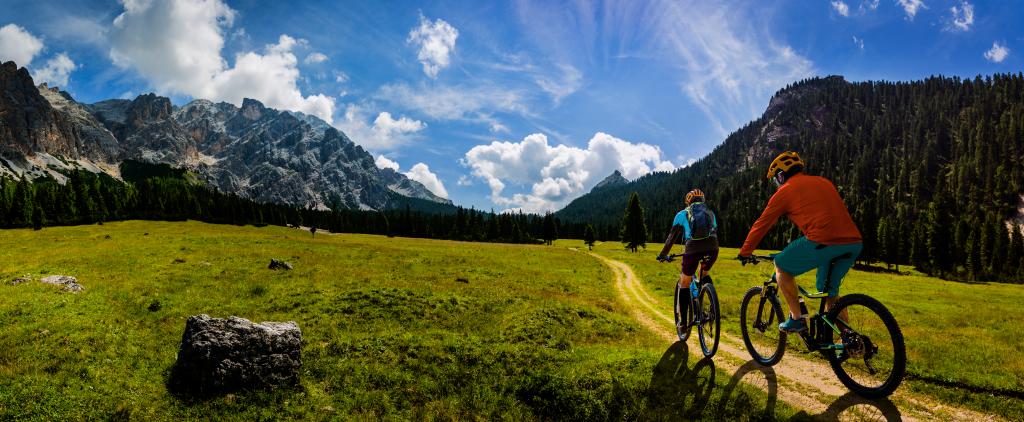
Source: Shutterstock
Hygiene has become more important during the COVID-19 pandemic. Although cycling tourists obviously run lower risks of infection, it is important to show that you take your customers’ health seriously. Make sure that you provide hand sanitizer, clean water and the option for social distancing where needed. Inform your customers of which measures you take to keep them safe.
Tips:
- Learn about managing the effects of COVID-19 in the tourism industry to find reliable sources about Europe’s COVID-19 situation. Read about how to respond to COVID-19 for a step-by step guide that can help you respond to and recover from the effects of the pandemic.
- Get to know you customers to find out about their specific wants. Find out what their experience and fitness level is, what they want to see and what they want to do next to cycling. To gain more insight in these side activities, read our studies on food tourism, community-based tourism, religious tourism and wellness tourism to learn more about other interests cycling tourists might have.
- Offer pick-up services, bike repair and maps to your cycling tourist customers. Both guided and self-guided cyclists want to feel secure when they are exploring an area they do not know, especially when it is far from home. It is important for them to know that they can call someone who can help them when their bicycle is broken, when they have lost their way or if they have any other troubles.
3. Which European countries offer most opportunities for cycling tourism?
The main European source countries for cycling tourism are Germany, the United Kingdom, the Netherlands, Denmark, Belgium and France. This selection is based on the popularity of cycling holidays combined with the willingness to travel to developing countries.
The number of cyclists and cycling trips has seen an increase over the years. It peaked in 2020 when COVID-19 became a global issue. Many people rediscovered their love for nature, exercise and desolated places during this time.
Germany
In 2020, during the pandemic, 51% of Germans enjoyed a cycling trip. This is many more compared to 2019, when 35% of Germans went on a cycling trip. Out of these cycling tourists, 90% travelled independently, while only 10% went on a mostly all-inclusive package holiday. Note that these number may be very different for long-haul destinations, since 88% travelled domestically. German men like to go on cycling trips more often than women. Young adults, adults and elderly people enjoy cycling equally often.
Based on research by the ADFC, most German travellers used a touring or trekking bike (65%), followed by a mountain bike (15%) and an urban/city bike (5%). Out of all bikes, 32% used an e-bike. Most cycling tourists travelled a cycling route using different accommodations (65%). Most travelled with their partner (54%), followed by friends (27%). 21% travelled alone, and 16% travelled in a small group. Only 4% went on a cycling holiday with children under 14.
German tourists like to be well prepared. Detailed information is important for them. They will look up reviews before booking their holiday and want as much security as possible. Good reviews, detailed information and insurance are key for Germans booking a holiday.
Germans like to go leisure cycling, either on their own or with a cycling partner. Around 44% of Germans use their bicycle on a daily basis. This makes them very familiar with bicycles. 7.1% of all Germans are involved in cycling as a sport.
Some German cyclists are members of a national or regional cycling association.
- Mountain Bike Verband is Germany’s association for mountain biking and has 80,000 members.
- Bund Deutscher Radfahrer is Germany’s national sports biking association. The association covers road cycling and mountain biking, including passion groups like dirt jumping. The association has 144,400 members and many regional associations too.
- The Algemeiner Deutsche Fahrrad-Club is an association that focuses more on tour cycling. This association has around 200,000 members.
Germany is a European leader in sustainability. Many Germans are keen on protecting the environment and enjoy going into nature. It is important to implement and communicate your sustainable practices if you want to attract Germans. Two great examples:
- Hauser-Exkursionen, a TourCert-certified tour operator, offers cycling tours to Zambia and Jordan.
- Bike Team is another example of a TourCert-certified German tour operator that offers trips to many different countries, including Namibia and Tanzania.
Germans like to go to any country because they are adventure seekers and speak English well.
Some Germans can also speak French or another European language.
United Kingdom
British people went leisure cycling more often during the COVID-19 pandemic to experience nature.
In 2020, during the pandemic, there was a 75% increase in leisure cycling compared to before the pandemic. British men cycle more than British women. Younger adults and adults over 40 cycle most often.
The United Kingdom is the largest source market for mountain bike tourism. Gravel biking in particular is becoming very popular, especially among British people.
British people often do not speak languages other than English. That means that they prefer to travel to English speaking countries.
The UK has several cycling associations.
- British Cycling is the British cycling association. It has 145,000 members and focuses on road cycling and mountain biking, including several passion groups.
- Cycling UK has 70,000 members and focuses mostly on tour cycling.
Many British people want to travel to a bucket list destination when travel restrictions are over. For example, they want to travel along the Inca trail or see Mount Kilimanjaro. They want to have a once-in-a-lifetime experience after being at home the past few years. If you want to attract British people, it is important to describe what makes your destination and your offer unique. They also want to go to nature-rich destinations, leaving cities and crowded places behind.
The Netherlands
In 2020, 2.5 million Dutch travellers enjoyed a cycling holiday. This number can be divided into 400,000 cyclists travelling from accommodation to accommodation, 1.6 million travellers using a fixed accommodation and 485,000 enjoying a mix of both. Many cyclists (33%) are aged 60 or older, but the popularity is rising among younger age groups.
The Netherlands has fewer inhabitants compared to the UK and Germany but can be an interesting target group for your cycling offer. This is because they are very familiar with cycling, have a lot of cycling experience and enjoy cycling a lot.
Many Dutch cycling tourists enjoy going on cycling holidays alone. Sometimes, Dutch people also like to go with their partner, especially the older cyclists that are travelling long distances. Dutch people seek adventure. They like to go anywhere possible for their cycling holidays. Most Dutch people speak English well and some even speak German, French or another European language.
The Dutch travel to work and to school and run errands by bicycle most often compared to other Europeans. Dutch people like to tour cycle around their home and will often go on day trips. This has increased over the past years especially among younger adults and the elderly.
Figure 6: The Netherlands, and especially Amsterdam, is famous for its high bicycle density
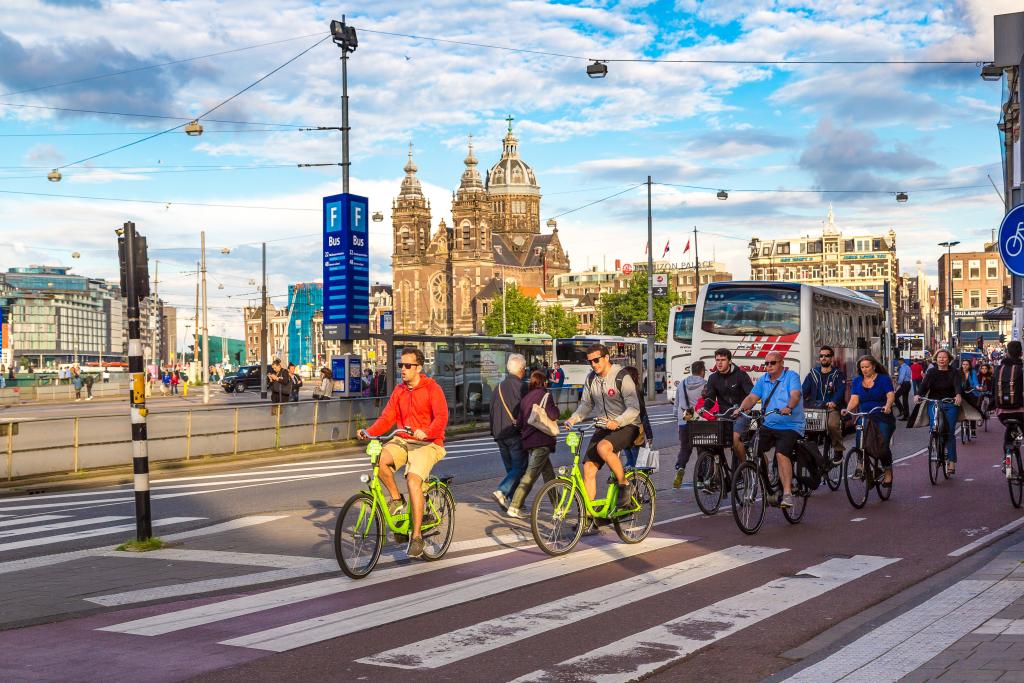
Source: Shutterstock
56% of Dutch people enjoyed a domestic holiday in 2020 that included a cycling day or multi-day trip. More families have also cycled during their holiday in 2020. This interest in cycling trips was influenced by COVID-19. Many people have said they feel inspired to go on cycling trips after the pandemic as well.
The Netherlands has around 330,000 mountain bikers and 850,000 road cyclists. Most Dutch mountain bikers and road cyclists are men, but more women are picking up the sports too. Part of these cyclists are organised in associations.
- Fietsersbond is the national cycling association of the Netherlands. It has around 31,000 members.
- The KNWU is the national association for road cycling and mountain biking, including several passion groups. The association has around 40,000 members.
SNP Natuurreizen is a Dutch tour operator with a high focus on sustainability and the largest supplier of cycling holidays in the Netherlands.
Denmark & Scandinavia
After the Netherlands, the small country of Denmark is perhaps the country with the most bicycle usage. The Danish, especially in Copenhagen, are cycling more and more. Denmark has good cycling infrastructure, which makes it easy for Danish people to travel by bicycle. This makes them experienced cyclists.
Almost half of the trips to and from work in 2018 in Copenhagen were by bicycle. Almost one fifth of the trips in Denmark take place on a bicycle. Like in the Netherlands, there is an increasing number of young adults cycling to and from school and university.
33% of all bicycle trips among Danish people are leisure trips. 7 out of 10 people in Denmark own a bike. In Copenhagen, this is even 9 out of 10 people. Cycling in Denmark is popular, especially in the capital city of Copenhagen. 10.2% of all Danes are involved in sports cycling.
Denmark and its neighbouring countries Sweden, Finland and Norway (together known as Scandinavia) have fewer inhabitants compared to other European countries. Scandinavia is rich in nature, and many Scandinavians love the outdoors. They like to spend time in the forest, on mountains and around lakes. This can make them an interesting market to target for cycling tourism. Mountain biking is especially popular among Scandinavians.
Associations:
- Cyklistforbundet is the Danish national cycling association. It has 16,000 members.
- Sweden has a national association for sports cyclists, including road cycling and mountain biking: Svenska Cykelförbundet. It has 70,000 members.
- The Swedish Cykelfrämjandet focuses on tour cycling and has 5,000 members.
- Norges Cykelforbund is Norway’s national association for sports cycling like mountain biking and road cycling. It has 40,000 members.
- Syklistforeningen is Norway’s cycling association for tour cycling, and it has around 10,000 members.
Belgium
Belgian travellers are more careful than, for example, Dutch and German travellers. Adventure travelling is less appealing to them because of the risks involved. They might be more interested in facilities such as hotels and restaurants. They will also want clear information to feel secure. Belgian cycling tourists are often road cyclists.
Belgian people often speak Flemish, English and French. Belgians are especially looking forward to travelling to long-haul destinations like Turkey and North Africa. They are expected to spend more on their holidays after the lockdowns caused by the pandemic. Belgians’ budget for package holidays has increased to €1,290 per person.
Associations:
- Fietsersbond België is the national cycling association, and it has 23,000 members.
- Belgian Cycling is the national association for sports cycling, such as road cycling and mountain biking.
France
French people like to go cycling. France is a nature and culture-rich country, and many French people enjoy a domestic trip. But the French also like to go abroad, mainly to French-speaking countries like Rwanda and Senegal. They like to go to places where they can speak French. Spanish speaking countries also have French tourists, because the languages are more similar compared to English.
More French cycling tourist like to go on a cycling holiday with a partner compared to other European countries. Like British people, French people often seek a bucket-list destination and enjoy sightseeing.
- Fédération Française de Cyclisme is the French national association for road cycling and mountain biking. It has almost 20,000 members.
Switzerland, Italy and Spain are not considered to be among the main European source countries. This is because they offer relatively few tour cyclists, which is the largest market segment in cycling tourism. However, if you offer road cycling tours, cyclists from these countries might offer great potential. This is especially true if you are based around the Mediterranean Sea.
Tips:
- Target Germany and the United Kingdom if you want to enter one of Europe’s largest markets for cycling tourism, especially if there is little competition in your area.
- Differentiate your offer by providing off-the-beaten-track routes, services unique to your location or a unique local experience. European tour buyers are more likely to offer your services if your offer is unique. Consult our tips for doing business with European tourism buyers to read about how to contact them.
- Get to know your customers and the language they speak. If your customers are German, Dutch or British, make sure you provide information in either English or their own language. Proper translation is important, because Europeans will find you more trustworthy. Provide information in French if you want to attract French tourists.
- Be accurate with the information you provide. Europeans can be critical customers. They like a lot of information-accurate pictures. They want to know what they can expect and what they are spending their money on.
4. Which trends offer opportunities in the European cycling tourism market?
Cycling tourism is seeing several trends from the cycling industry. These trends offer opportunities for you to advertise, attract European cyclists and meet their demands.
Increased social media and blog usage
Cyclists often take their inspiration from cycling travel blogs. These blogs provide descriptions of other travellers’ cycling experiences on certain tours. Cyclists look for these blogs to gain inspiration and to get information on the cycling tour, facilities along the way, safety and things to do. Some examples:
- WeLeaf offers a website including many blogs. It was developed by two very experienced cycling tourists from the Netherlands and Belgium and offers travel tips, inspiration, information on equipment and more. The blogs include a route description, highlights, information on accommodations, food and water and much more. Its main focus is on tour cycling, but it also has information on hiking, sailing and canoeing.
- Epic Road Rides offers a platform for road cyclists with a huge number of tours all around the world.
- Single Tracks is a platform with tips on gear and offers inspiration on mountain bike trails all around the world.
Cycling tourists often also use Instagram or Facebook to show their followers, friends and family pictures or videos of their trip. Some cyclists, especially mountain bikers, use a GoPro to film their trip and post it on Instagram or YouTube.
E-bikes and mobile apps
E-bikes are bicycles that are powered by electricity. Cyclists on e-bikes do not have to pedal as hard and can go faster if they want. E-bikes are becoming increasingly popular among cycling tourists. Elderly people use e-bikes the most. They can cycle longer distances with less physical strain. Many adults and younger adults are also interested in renting e-bikes.
E-mountain bikes are also being used more often. Travellers who have no or less experience with mountain biking are likely to use e-mountain bikes. These people may be active in other areas and want to try mountain biking as an extra holiday activity.
If you offer tours for both regular cyclists and cyclists on e-bikes, consider putting them in different tours. E-bikes often go much faster than regular cyclists. This makes it difficult to stick to the tour group and guide. If you want to attract e-bike cyclists, it is important to provide an e-bike rental service. People cannot take their e-bikes on a plane because it is not allowed.
E-bike cyclists often go on one-day trips, because it is often challenging to find facilities to charge the bike in remote areas.
Next to that, apps to navigate cycling trails are becoming more popular. It is important for cycling tourists cycling in remote areas to access the navigation app at all times. Internet access is not always available in remote areas. It is important to be able to download a cycling map from the app, so that cyclists can still travel safely.
Apps that are popular among cycling tourists are EuroVelo, Strava and Komoot. The EuroVelo app provides cyclists with an interactive map, sights to see in the area and the opportunity to share the cycling trip with friends and family. Strava is often used by road cyclists. The app maps out routes and can calculate heart rate, speed and distance. You can follow other road cycling friends and share your achievements with them as well. Komoot is also particularly popular. This app is ideal for planning routes and is full of highlights from other cyclists. Offline use is possible by downloading the maps.
Bikepacking is on the rise
Bikepacking is a form of cycling tourism similar to backpacking. Bikepackers are self-supported cyclists that carry their own luggage and explore a variety of trails on a multi-day journey. Bikepackers often use gravel bikes because they are cycling on different terrains. They often go off the beaten track and seek out local experiences on their own. They are very minimalistic travellers and carry their own luggage. Bikepackers do not want to be supported by a tour guide, but make use of travel blogs, social media and maps to gain inspiration and tips.
Figure 7: Bikepackers travel light and seek their own route
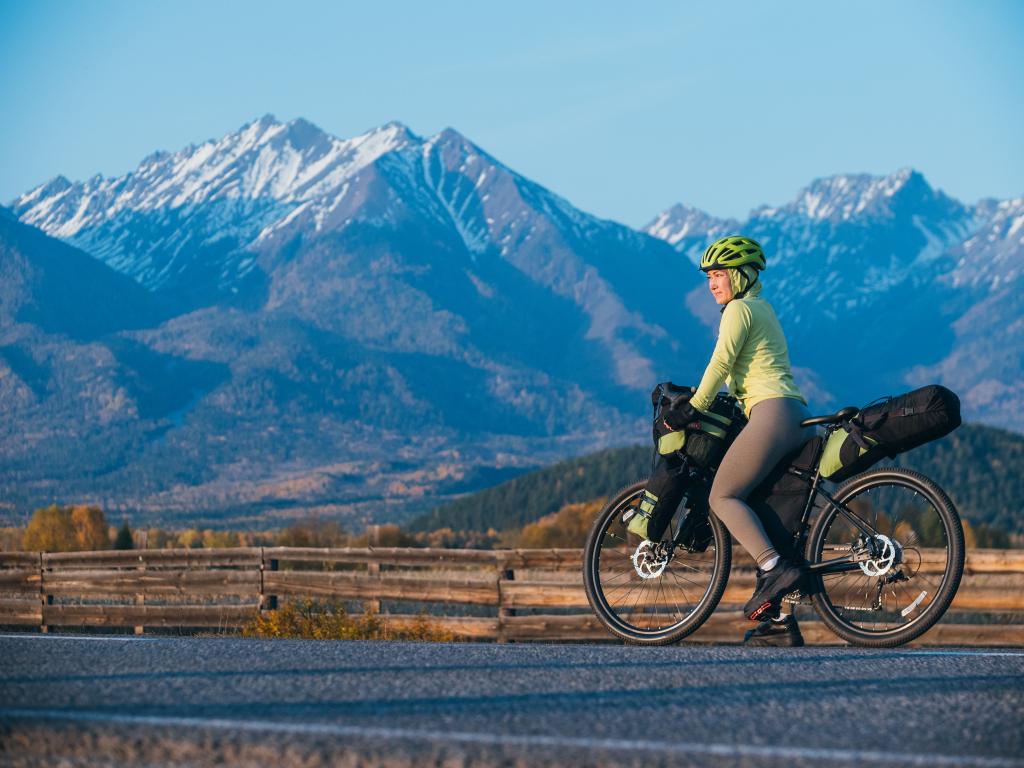
Source: Shutterstock
Bikepacking.com is a popular website where bikepacking is explained, routes are described and suitable bicycles for bikepacking are described.
Local experiences
Cycling tourists want to be immersed in the local experience. This means that they like to enjoy local food, connect with local people and join in on local activities. Many cycling tourists would rather have a local experience than cycle to popular sites that are often overcrowded. Cycling tourists find it important to support the local community they bike through, such as having tea or lunch in a local home, staying overnight in a homestay or helping out a local farmer for a day. An example of a company combining cycling with exploring local cultures is Follow me Bangkok Tours.
Cycling tourists are nature-lovers
Cycling tourists often seek nature-rich destinations. Scenic routes are important for cycling tourists. They like to enjoy mountainous areas, see lakes or cycle through forests. Provide information to cyclists about what scenery they can expect during their cycling trip. Pictures and accurate descriptions inspire cyclists to come to your destination.
People want to reconnect with nature, especially after COVID-19. People explored their home country more during lockdown. Now, they would like to explore nature abroad if travel measures allow it. Remote areas, away from the crowd and popular sights, have become very interesting for European travellers. Cycling is a great way to explore and connect with nature while travelling.
Include and communicate about sustainability
Many cyclists care about sustainability. At least 7% of the daily cyclists travelling to work or school are motivated to cycle because it is more sustainable than travelling by car.
If you want to attract Europeans, it is important that you find ways to be sustainable and can communicate this to your customers. Sustainability comes in many forms. Europeans find it important that you offer local products, connect them with sustainable hotels or homestays and offer sustainable activities. While sustainable cycling tourism focuses on travel with a minimal impact, regenerative tourism aims to improve the destination. Therefore, regenerative tourism is the next step in sustainable travel.
One Bike is a cycling tour operator in Tanzania that organises special tours that empower the local community and clean up the local environment. For example, it organises ‘Re-Cycle Tours’ where cyclists clean up litter found in nature and bring it to a recycling manufacturer in the neighbourhood. It also has a ‘One Bike Nomad’ tour, where One Bike and volunteers cycle to a nearby town in Tanzania and help the community fix their broken bicycles.
Watch One Bike’s company film for inspiration on how they use cycling tourism to contribute to a cleaner environment.
Tips:
- Read about how to be a sustainable tourism business to learn how you can include sustainable practices in your offering. Europeans value sustainability, and it can influence their decision about buying your offer. If your sustainability goals are even higher, read our study on regenerative tourism
- Advertise in cycling magazines. There are few cycling magazines, so the chances you will stick out is larger. Bicycling is an example of a magazine in which you can advertise your services and destination to attract cycling tourists.
- Read our study on how to start a travel blog. Cycling tourists get inspired by cycling travel blogs. Make sure to provide accurate pictures and information on what tourists can expect from your offer.
- Build a social media profile for your business. Many cyclists have social media and post pictures online of their trip. They can tag you if you have an account. This way, more people will get to know your business. Read our article on trends that offer opportunities or pose threats on the European outbound tourism market to learn more about other trends that can influence Europeans’ travel behaviour.
This study was carried out on behalf of CBI by Molgo and ETFI.
Please review our market information disclaimer.
Search
Enter search terms to find market research

